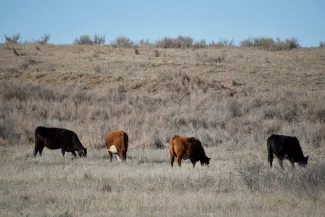
The Wildlife Department’s grazing lease program brings cattle onto its management areas during the growing season to the benefit of Oklahoma’s wildlife.
Throughout the month of April, the Wildlife Department will be opening several of its Wildlife Management Area gates to grazing lease operators as they haul in the year’s allotted cattle. But where some may only see stocker calves or cow-calf pairs grazing in a pasture, wildlife biologists like Weston Storer see four-legged habitat machines.
Storer manages three of the Wildlife Department’s WMAs and offers a grazing lease on each of those areas, encompassing more than 12,000 acres of mixed-grass prairie in northwestern Oklahoma. While the individual lease details vary, the goal remains the same – use cattle to influence the composition and structure of the plant community, which can in turn benefit the wildlife community.
“The cattle aren’t just grazing in a pasture, they’re being used to manipulate the area’s wildlife habitat,” Storer said. “They’re removing old growth; limiting the new growth of the year; and because they’ll graze different areas more heavily than others, they’re creating a patchwork of diversity. Grazing really is one of the best habitat tools we can use in western Oklahoma.”
A Win-Win for Wildlife and Livestock Producers
The Wildlife Department does not own any cattle and instead leases the grazing rights to about 20% of its Wildlife Management Areas to regional producers in a sealed public bid. The bids are typically advertised at the start of the new year and are awarded by early February. The resulting lease agreements identify the number of cattle that may be stocked on each of the participating WMA’s pastures and sets the annual contract lengths.
“For the leases on Cimarron Hills and Cimarron Bluff WMAs, the stocking rate has been set at about 20 acres per cow-calf pair,” Storer said. “And the cattle will graze until the end of August – for about 150 days.”
This stocking rate is generally thought of as light to moderate for the region and allows for half of the vegetation to be removed. A quarter of the vegetation is expected to be eaten by the cattle and another quarter is expected to be trampled. That leaves half of the vegetation for wildlife.
This formula works well for a variety of wildlife species – the grazed areas and resulting trails can help keep travel lanes open for smaller species like quail and horned lizards, and the remaining vegetation can be used as food or nesting or escape cover. And ending the lease before the end of the growing season allows the grazed vegetation to recover and set seed, ensuring quality habitat persists through the winter.
While the Wildlife Department makes use of a number of habitat management tools, including prescribed fire, its grazing leases offer biologists an age-old technique for manipulating the composition and structure of vegetation for the benefit of wildlife. Where some merely see cattle grazing in a pasture, the Wildlife Department knows the true value of these four-legged habitat machines.
Want to learn more about how Storer determines stocking rates for his grazing leases? Check out this deep dive on prescribed grazing from our Oklahoma Quail Habitat Guide.
